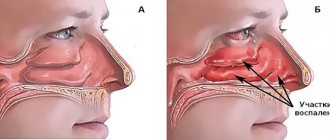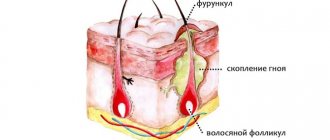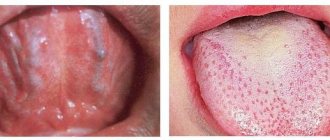Purulent nasal discharge can appear for many reasons and necessarily require treatment. You should not carry out therapy on your own due to the risk of severe complications if treated incorrectly. As soon as purulent discharge from the nose is noticed, you should immediately seek medical help from an otolaryngologist, or, in his absence, a therapist. The fact that pus, and not ordinary snot, began to come out of the nose can be understood by a special, extremely unpleasant odor, which does not occur with a simple runny nose. The yellow-green color of the discharge also differs from the usual one.
The appearance of pus from the nose can be associated with a number of diseases. In order to effectively treat a problem, it is necessary to accurately determine the reason why it occurs. If you seek medical help in a timely manner, the therapy quickly produces positive results and nasal discharge disappears. If for some reason the disease turns out to be advanced, then treatment may take a long time and sometimes require surgical intervention. The appearance of pus from the nose occurs equally in adults and children and requires similar therapy. It is not uncommon for purulent nasal discharge to appear after viral infections as a complication of the disease. In order to prevent this phenomenon, it is necessary to fully treat the primary disease without suffering it on your feet.
When the pus is liquid and white, this is an indicator of the initial stage of the disease. In this case, it is released in large quantities, and also often flows down the back wall of the pharynx. If the particles of pus are viscous and more like lumps, then this is an indicator of severe neglect of the purulent process. Most often, with long-term disturbance, green nasal discharge occurs. The formation of pus is always associated with the penetration of pathogenic bacteria into the nasal cavity. If they are absent, then a purulent process cannot occur. Because of this, in the viral form of rhinitis, the appearance of pus always indicates a secondary bacterial infection.
Reasons for the problem
Most often, the appearance of pus from the nose is associated with lesions of the paranasal sinuses, which become inflamed when they are blocked and mucous secretions accumulate in them. In addition, an unpleasant phenomenon can occur as a consequence of injury or the formation of an abscess in the nasal cavity.
Sinusitis
Sinusitis is the most common cause of pus from the nose. The discharge can be not only green, but also brown mixed with blood. With this disease, an inflammatory process develops in the maxillary paranasal sinuses. The disease is often provoked by the presence of carious teeth in the upper jaw. The symptoms of this disorder are as follows:
- temperature rise to 38 degrees and rarely higher;
- headache;
- feeling of heaviness in the head;
- loss of smell;
- a sharp decrease in performance;
- severe weakness;
- sleep disorders.
A problem arises not only because of diseased teeth, but also with insufficiently treated runny nose, nasal injuries and decreased immunity, which can even occur due to significant hypothermia.
Lack of treatment is very dangerous. Sinusitis, more often than other diseases with the discharge of pus from the nose, causes severe complications. After sinusitis has been suffered once, the risk of its reoccurrence becomes quite high.
Nasal polyps
Polyps are benign growths and often appear in the nasal cavity. By their nature, polyps are a proliferation of tissues of the nasal mucosa. With this phenomenon, chronic nasal congestion, decreased sense of smell, frequent headaches and a nasal voice occur. Due to the fact that polyps disrupt the outflow of mucus from the paranasal sinuses, a purulent process begins to develop in the latter. As a result, unpleasant nasal discharge appears.
The treatment of this disease is surgical. If the polyps are not removed, the disease will not be cured. However, even after surgery there is no guarantee that polyps in the nasal cavity will not reappear. Sometimes a person can suffer for years as they develop again.
Rhinopharyngitis
With this inflammatory disease, simultaneous inflammation of the nasal and pharyngeal mucosa occurs. The disease most often occurs against the background of viral infections such as influenza, acute respiratory infections and ARVI. The main symptoms of nasopharyngitis are:
- itching and burning in the nasopharynx;
- difficulty breathing through the nose;
- nasal voice;
- difficult separation of mucus and pus from the nasal cavity, which may also contain blood, causing the discharge to be brown;
- enlarged lymph nodes in the back of the head;
- swelling of the nasopharyngeal mucosa;
- temperature increase.
Treatment of inflammation requires comprehensive treatment. If it is delayed, damage to the mucous membrane may become irreversible. There is also a risk that there will be a change in the tissue of the pharyngeal tonsils, and then their removal may be necessary for treatment.
Ozena
Fetid runny nose ozena refers to severe lesions of the nasal mucosa that require urgent treatment. The disease is also called atrophic rhinitis. Its main manifestations are:
- purulent nasal discharge with a strong and very pungent rotten odor;
- complete loss of smell, even for very strong odors;
- constant presence of dry crusts in the nasal passages.
Ozena develops if a person has chronic rhinitis for a long time, which is not treated. Its presence at the beginning is indicated by a large volume of transparent watery discharge. As a result of this, gradual atrophy of the mucous membrane occurs, due to which irreversible changes occur in it and a special purulent process develops.
Bacterial lesions
Bacterial lesions of the nasal mucosa also often occur and cause the appearance of pus from the nose. More often, such bacterial infections appear in children, since their immunity is not strong enough. In adults, initial bacterial infection occurs rarely and only in cases of severe weakening of immunity. The pus may be curdled, yellow-orange or dark green.
Complications of injuries and operations
Purulent nasal discharge can also appear if there has been an injury or surgery, and after that a bacterial infection develops as a complication. This phenomenon indicates that after injury or surgery, improper treatment was carried out with infrequent changes of tampons and insufficient use of antibiotics. Also, pus may appear if the surgeon initially violated the sterility during the operation and pathogens were introduced into the nasal cavity. Most often, this complication develops if the operation was extensive, and subsequently the patient himself violated medical recommendations.
Purulent nasal discharge
The appearance of purulent nasal discharge can occur for various reasons. But regardless of them, you need to contact an otolaryngologist, and if this is not possible, then a therapist. We do not recommend trying to get rid of the problem yourself.
The discharge is yellow-green in color and has an unpleasant odor. Additionally, discharge of pus from the nose may be accompanied by headaches, general malaise, chills, itching and pain in the nose.
Causes of purulent nasal discharge
The cause of pus in the nose is considered to be damage to the paranasal sinuses. A blockage occurs, and a mucous secretion accumulates in the sinuses, which can later become inflamed. Additional reasons may be the consequences of injury or the occurrence of an abscess in the nasal cavity.
But the main cause of pus is considered to be diseases of the nasal cavity. To eliminate them, you need to consult a doctor who will prescribe treatment and give recommendations. Therapy for adults and children is almost the same. If you consult a doctor in time, the treatment will not be long and surgical intervention will not be required.
At the initial stage of the disease, the pus has a liquid structure and white color. The volume of discharge is small, it can flow down the back wall of the throat. If the viscous structure predominates, this means that the purulent process has entered an advanced stage and urgent treatment is required.
Diseases accompanied by the discharge of pus
To determine the cause and diagnose the disease, it is necessary to consult an otolaryngologist, and at the diagnostic stage it is already possible to distinguish:
- sinusitis;
- nasal polyps;
- nasopharyngitis;
- ozena.
Purulent discharge may be the result of bacterial infections or complications after injury or surgery. Mostly children are susceptible to bacterial infection due to insufficiently strong immunity. In adults, this is rare and occurs only when the immune system is severely weakened and the body is weakened.
Sinusitis
The development of sinusitis is one of the main reasons for the appearance of pus from the nose. With this pathology, inflammation of the maxillary paranasal sinuses is observed. Purulent discharge has a greenish color, sometimes it can turn brown due to inclusions of blood. The development of sinusitis can be triggered by the presence of carious teeth in the upper jaw.
The following symptoms are noted for sinusitis:
- elevated temperature (from 38°C);
- constant headache that cannot be relieved with medications;
- feeling of heaviness in the head;
- loss of smell;
- general weakness and decreased performance;
- sleep problems.
The occurrence and development of sinusitis can occur not only due to diseased teeth. The cause of the occurrence and development of the disease can be an untreated runny nose, injury, decreased immunity and hypothermia.
When you notice the first symptoms of the disease, you should seek medical help and not try to cure yourself. If not treated correctly, the disease can have serious consequences. If you have had sinusitis once, the risk of the disease recurring will be higher than for a person who has not had sinusitis.
Nasal polyps
Polyps are benign growths and often appear in the nose. But with further growth in the mucous membrane, chronic nasal congestion may occur, a nasal voice may appear, and the sense of smell may decrease. The development of polyps may be accompanied by frequent headaches.
Excessive enlargement of polyps disrupts the proper functioning of the nasal cavity, and the outflow of mucus is disrupted. Inflammatory processes begin to develop in it, which leads to the formation of pus.
The problem cannot be solved with medication; surgery will be required. But even removing polyps does not guarantee that they will not appear again in the future.
Rhinopharyngitis
The disease is accompanied by a simultaneous inflammatory process in the nasal cavity and larynx. The emergence and development of the disease occurs after viral diseases (ARD, ARVI). Symptoms include:
- itching and burning in the nasopharynx;
- disturbances in breathing through the nose;
- change in voice (nasality);
- discharge of mucus and pus from the nose, sometimes the color may turn brown due to the presence of blood;
- swelling of the nasopharynx;
- temperature increase.
To eliminate the problem, it is necessary to carry out complex treatment. If you postpone it, then nasopharyngitis will provoke irreversible changes in the body. In an advanced stage, changes in the tissue of the pharyngeal tonsils may occur, which will require their removal.
Ozena
Ozena is sometimes called atrophic rhinitis. When the disease occurs, damage occurs to the nasal mucosa, accompanied by an unpleasant odor. When the first signs appear, you must consult a doctor and undergo urgent treatment.
Symptoms of the disease:
- purulent nasal discharge, which has a strong and pungent unpleasant rotten odor;
- the sense of smell disappears;
- Dry crusts constantly form in the nasal cavities.
The development of ozena can occur after prolonged chronic rhinitis. This is especially noted in the case when rhinitis was not treated and became chronic. The initial signs are the presence of a large amount of transparent discharge. At first they have a watery structure, but later atrophy of the mucous cavity occurs. After some time, the inflammatory process enters a critical stage, and pus begins to discharge from the nose.
Discharge of pus from the nose can occur due to injury or surgery. The situation is also possible if a bacterial infection has occurred. The appearance of pus indicates that the treatment was carried out incorrectly, or there was non-compliance with the doctor’s recommendations in the postoperative period and infection in the operated area.
What you need to know about purulent nasal discharge
If purulent discharge is detected, you should seek medical help and not self-medicate. Timely treatment will have a positive effect, quickly get rid of the problem and avoid complications. If treatment is neglected, the risk of complications increases and surgery may be required. The longer you wait to see a doctor, the more effort and time it will take for a full recovery.
How is the treatment carried out?
There are two methods used to treat nasal discharge of pus. This includes medication and surgery. Drug treatment uses antibiotics to help the body cope with the disease. But they contain components that can affect the intestinal microflora. To level out the effects on the body, probiotics are prescribed to help avoid intestinal problems.
Additionally, the doctor may prescribe the use of vasodilators, which help reduce swelling of the mucous membrane and improve the outflow of contents of the paranasal sinuses. Sometimes it is recommended to take painkillers and antipyretics. If the separation of mucus from the nasal cavity is associated with difficulties, then rinsing the nose with an isotonic saline solution is prescribed.
Surgery may be required when polyps are present in the nasal cavity and there is an urgent need to clear pus from the paranasal sinuses. The operation does not require hospitalization and is performed under local anesthesia. After the intervention, the doctor will give recommendations that should be strictly followed to avoid complications.
The postoperative period is accompanied by a mandatory course of antibiotics, which reduces the risk of purulent complications and maintains the body's protective functions.
If you notice purulent nasal discharge, you can call our clinic and make an appointment. After the examination, the doctor will prescribe treatment and give recommendations on further prevention from the development of the disease. If necessary, our doctors will perform an operation and help resolve the problem. After the procedure, the patient can stay in a free hospital for several hours. This will help him recover from the effects of anesthesia, and the doctor will be able to monitor his well-being.
Author
Sadrtdinov Alik Gadelyanovich
otorhinolaryngologist (ENT)
Candidate of Medical Sciences
25 years of experience
+7
Microbiological examination of pus and discharge from the wound
Many bacteria that colonize on the skin and mucous membranes can contribute to skin and soft tissue infections. Acute skin infections often occur after surgery or injury. Chronic infections occur due to chronic lack of blood supply, bedsores or metabolic disorders. Various microbes colonize the wounds that appear; microbiological culture is indicated in cases where signs of inflammation occur in the wound (redness, swelling, pain, increased local temperature, discharge) or in cases where wound healing is slow. The best material is aspirate from the wound or a piece of tissue; the worst is material taken with a swab.
The most common causative agents of wound infections are Staphylococcus aureus, Streptococcus pyogenes, Pseudomonas aeruginosa, enterobacteria and anaerobes. For burn wounds, material should be taken from different areas of the wound due to the fact that bacteria colonize unevenly on their surface.
| Clinical picture | Most common pathogens | Comments |
| Superficial infections: Erysipelas, cellulite, cyst, carbuncle, folliculitis, wounds, subcutaneous abscess, abrasion, 1st degree burn wounds | S. aureus including MRSA KONS streptococci groups A, B, C, G Peptostreptococcus Corynebacterium spp. Herpes simplex | HSV - can be determined by PCR |
| Deep wound infections: Animal bite | Pasteurella multocida Capnocytophaga spp. Eikenella corrodens | Aeromonas spp., Vibrio spp., Capnocytophaga violaceum can occur in wounds that have been in contact with water from the external environment |
| Deep wound infections: Human bite Burn wounds II, III degrees Surgical wounds Pressure ulcers Trophic ulcers | Aerobic and facultative anaerobic bacteria, anaerobic bacteria may also occur | |
| Abscess Discharge from drainage Piece of cloth | Mixed infection of aerobic and facultative anaerobic bacteria, may also contain anaerobic bacteria | Microscopy may indicate anaerobic infection |
Indications:
- Suspicion of acute or chronic wound infection
- Poorly healing wound
Tested material: Discharge from a wound, pus, discharge from an ulcer, discharge from a trophic ulcer, material taken from an abscess
Method of analysis: Microscopy of native material, aerobic culture on media, identification of the causative agent, determination of drug sensitivity
Interpretation of the result:
- Microscopy shows a large number of polymorphonuclear leukocytes indicating an inflammatory and infectious process, and the morphology of bacteria and the possibility of anaerobic infection are also assessed. If the patient has an immunodeficiency or circulatory disorders, then the inflammatory reaction cannot be assessed in the drug, since if there is an infection, there may be no leukocytes in the drug itself.
- NB! Many wound infections are polymicrobial, and the appearance of bacteria can indicate either infection or colonization. Therefore, the answer given by the laboratory is inconclusive, and the need for treatment is decided on the basis of all clinical information, the microscopic picture and the specific isolated pathogen.
Pus
Pus is a cloudy liquid that occurs as a result of serous-purulent or purulent inflammation. Essentially, pus is destroyed white blood cells that have completed their life cycle.
Suppuration is the process of formation of pus.
Pus consists of the following components:
- Serum. It contains globulins, albumins, lipolytic and glycolytic enzymes, an admixture of DNA, fats, lecithin, and cholesterol.
- Tissue detritus. It is represented by dead matter.
- Cells of degenerated or living microorganisms, neutrophilic leukocytes. In some cases, the pus may include mononuclear cells and eosinophils .
The color of pus depends on the causes of its occurrence. It can be green, gray, yellow, green-yellow and even bluish. Fresh pus is much thicker than old pus. Most often, the smell of pus is not strong, only slightly specific, but when putrefactive inflammation occurs, its smell can become very strong. The localization of the inflammatory process, the pathogen, the degree of tissue damage, communication with hollow organs determines the consistency, color and smell of pus, which are different for each specific case.
Microorganisms that caused the development of suppuration can almost always be found in pus. Pyogenic bacteria are usually the cause of the development of this process. These bacteria include Escherichia coli , anaerobic clostridia, streptococci, gonococci, staphylococci, meningococci, etc. In this case, the process of formation of pus can be the result of the activity of other bacteria in the tissues and organs, for example, candida, salmonella, pneumococci, mycobacteria , etc. In this case, there may be cases where no microorganisms are found in the pus. This situation is associated either with the destruction of bacteria by enzymes, or with a non-microbial cause of suppuration.
Pus is subject to mandatory examination, like blood, urine and other body fluids, especially when there are large accumulations of it in the cavities. In cases where accumulations of pus are in open cavities, the collection is made from the depths of the lesion, when in closed cavities a puncture . The obtained material is examined immediately after collection in order to prevent possible decomposition of microorganisms by the enzymes that make up the pus, that is, in order to avoid the lysis process.
In the event of purulent wounds, their treatment must be carried out using special methods that avoid sepsis - an extremely serious condition in which microorganisms enter the blood. To prevent complications, drainage of pus from wounds is ensured using various antiseptic methods (catheters, special tampons, etc.). In some cases, wounds are washed with special means.








